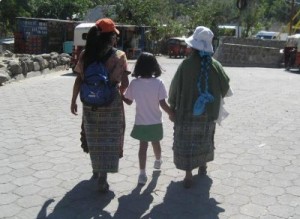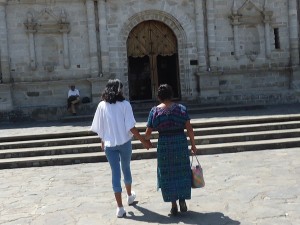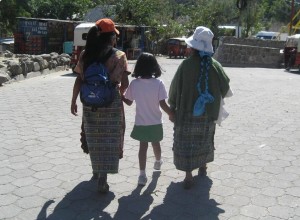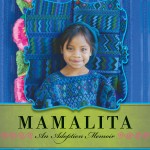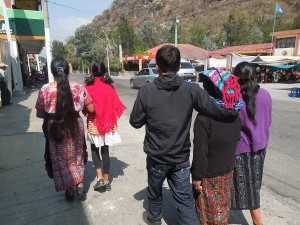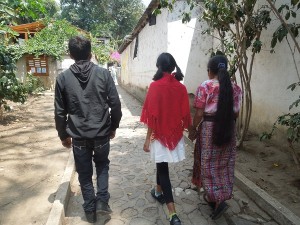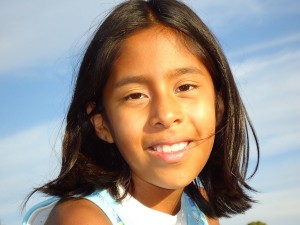Last week, Olivia said, “Are you going to post one of those photos of me with ‘Ana’ from the back?” A picture from our annual visit with Olivia’s birth mother, and one of Mateo with Olivia’s Abuela. I love that we all meld together into one family.
Posts Tagged ‘birth family reunions’
Visit summer 2017
Thursday, August 24th, 201730 Adoption Portraits essay
Thursday, November 3rd, 2016I’m thrilled that my essay is included in the sixth annual “30 Adoption Portraits in 30 Days,” a November series that features posts by people who are adopted, birth parents, adoptive parents, waiting adoptive parents, and foster parents-turned-adoptive parents.
My first sentence: “The Guatemalan searcher I hired to find my daughter’s birth mother, Ana, told us to meet in Panajachel, the town guidebooks refer to as Gringotenango. ‘In the village where Ana lives, San Luis, they don’t see a lot of white people,’ the searcher explained, referring to me, the white adoptive mother. ‘Better to meet someplace else.’”
Thank you for reading!
Birth family visit 2016
Thursday, July 28th, 2016Realize I never posted a photo from our visit this summer with Olivia’s birth mother in Guatemala. In the photo above, they’re walking into the church in Panajachel, where every year we pray together and light candles.
And in the photo below, from their first reunion, when Olivia was age seven, with Abuela.
Excerpt from Mamalita
Wednesday, January 6th, 2016I’m honored (and surprised!) that Adoptive Families magazine recently posted this excerpt from Mamalita–the final chapter. (Thank you!) As you know, eight years after adoptions between the US and Guatemala closed, some 6 to 8 families still wait for resolution of their cases. As I remember our story, I think of them. ~
Here are the first few excerpted paragraphs:
Because of Olivia, everything else in my life finally made sense. My failed first marriage. My early menopause. The sequence of boyfriends who had rejected me because of my infertility. Meeting Tim. All of it had had a single purpose: to lead me to her.
My parents welcomed Olivia with open arms. Family and friends clamored to meet her. She was the undisputed star of every social gathering. I felt more settled and happy than I ever remembered.
But as the years passed, scrutiny of Guatemalan adoption increased. One night, Tim came home to find me on the family room sofa surrounded by a pile of used tissues. I was watching a television newsmagazine about adoption practices in Guatemala. Much of the show was shot with hidden cameras in the shadowy hallways of a “baby hotel,” which I recognized as the Camino Real. The report focused on one particular “broker,” a nefarious character who kidnapped babies from their Guatemalan mothers and sold them to unsuspecting, infertile couples in the United States. Although the “broker” had been banned from facilitating adoptions by the U.S. Embassy, unscrupulous agencies continued to use him.
Tim stared at the TV screen in disbelief. “That’s our facilitator,” he said. In most international adoptions, contact with birth mothers was impossible because little information was known. In Guatemalan adoption, however, most families had access to a birth mother’s name and cédula number — a national identity card — at a minimum. We possessed that information about Olivia’s birth mother, Ana. It would be possible to hire someone to find her.
Read the rest here.
Semana Santa 2013. A visit with Olivia’s birth family
Friday, April 5th, 2013
This week, we met with Olivia’s birth family in Panajachel, a town on Lake Atitlan about three hours northwest of Antigua. The family—Olivia’s birth mother, “Ana”; her grandmother, Abuela, and her older brother and sister, now 18 and 16—traveled to Pana by bus from where they live in Totonicapan. Opinions around the subject of international adoption are mixed in Guatemala, ranging from supportive to very negative, so to protect Ana’s privacy we always meet in Pana, two hours from her town. (In small villages such as the one where they live, outsiders never pass unnoticed.) As you can see from the photo, Olivia is almost as tall as Ana, and about the same height as Abuela. Olivia had just turned seven the first year she met her family; next month she will be 11.
This meeting was a little different from our previous ones for two reasons: first, because my sister Patrice usually accompanies us on birth family visits and couldn’t this time. (We missed you, Tia!) And second, because Abuela’s shoulder was bothering her so much she couldn’t move her arm to do anything, including lift a fork to eat. The lightest touch caused her to wince with pain. Bear in mind, this is a woman who for decades has chopped firewood, hauled water, made tortillas, and washed thousands of loads of laundry by hand.
Olivia wanted to take a boat ride to another village on Lake Atitlan—she doesn’t like to feel conspicuous in “our” town of Panajachel—so we did. As usual, our first stop was to pray together in the town’s Catholic church, and may I just say that the faith and goodness of Olivia’s birth family absolutely humbles me.
Afterwards, we ate a nice lunch, over which we perused the photo albums from last year’s visit that I had assembled and brought. But none of us could ignore Abuela’s obvious suffering. Trying to ascertain the exact nature of the problem, I could make out the Spanish word for “bone,” although nothing about a fall or injury. As far as I could determine, a visit to their local clinic in Toto hadn’t revealed a root cause.
Long story short, I called Nancy Hoffman, my fellow adoptive mom who owns a travel agency in Antigua, and she said the desk clerk at our hotel knows a good doctor. Turned out he does: Dr. Luis de Pena, the physician who runs the clinic at Mayan Families, the NGO many of us adoptive families support, and where, in fact, I had been last month with Mateo, dropping off shoes donated by Olivia’s Girl Scout troop.
Our group clambered onto the next boat to Pana, piled off and into two tuk-tuks, and zipped up to Mayan Families.
After a physical exam, Dr. de Pena made a diagnosis: bursitis. If the injection he administered doesn’t work—he sent me out to buy the syringe from an NGO-subsidized pharmacy around the corner and two blocks down, “Fe, Salud y Vida”—and other causes are ruled out, Abuela may need surgery. This only can be performed in a hospital by an orthopedic surgeon, and in Guatemala, apparently, orthopedic surgeons’ numbers are few. If necessary, Abuela must travel to Guatemala City or Quetzaltenango.
Today’s report is that the pain has subsided somewhat. We’ll see.
What I appreciated most about this visit was how natural it felt. Abuela was in pain, and we did our best to help her feel better. That’s what family does, and we’re family.
Ballerina adopted from Sierra Leone, with a birth family reunion sub-theme
Saturday, July 14th, 2012As the daughter of a former Rockette who owned a dance studio—my mother—I must post a link to this Associated Press article about an amazing 17-year-old ballerina, Michaela DePrince, who was adopted as a child to a family in the U.S. from an orphanage in Sierra Leone, and is set to debut in her first full-length professional ballet. The primary focus of the article is compelling enough, but if you read through to the last paragraphs, you’ll discover another reason why I’m posting about it now.
Michaela DePrince was little more than a toddler when she saw her first ballerina — an image in a magazine page blown against the gate of the orphanage where she ended up during Sierra Leone’s civil war. It showed an American ballet dancer posed on tip toe.
“All I remember is she looked really, really happy,” Michaela told The Associated Press this week. She wished “to become this exact person.”
From the misery of the orphanage “I saw hope in it. And I ripped the page out and I stuck it in my underwear because I didn’t have any place to put it.”
Now Michaela’s the one inspiring young Africans: She escaped war and suffers a skin pigmentation disorder that had her labeled “the devil’s child” at the orphanage. She’s an African dancer in the world of ballet that sees few leading black females. She was adopted and raised to become a ballerina in the U.S. — a country where she believed everyone walked around on tippy toes.
***
“I lost both my parents, so I was there (the orphanage) for about a year and I wasn’t treated very well because I had vitiligo,” [Michaela] said Monday. “We were ranked as numbers and number 27 was the least favorite and that was my number, so I got the least amount of food, the least amount of clothes and what not.”
***
Michaela said the war and her time in the orphanage affected her for years.
“It took a long time to get it out of my memory. But my mom helped me a lot and I wrote a lot of stuff down so I could recover from it,” she said. “Dance helped me a lot. I had a lot of nightmares.”
[Adoptive mom Elaine] DePrince and her husband Charles have adopted nine children, and had two biological sons. Two of Michaela’s brothers died before she was born, and a third died when she was young. Their deaths were a result of HIV contracted from a manufactured plasma product that was used to treat the hemorrhages associated with hemophilia.
[Elaine] DePrince said the family has worked hard to develop all their children’s dreams.
Now for the part I mentioned in the first paragraph:
“She says she would have not had this dream come true if she had not become Michaela DePrince” by adoption, [Elaine] DePrince said, adding that none of the three girls adopted from Sierra Leone have expressed interest in finding their biological family.
The last half of the last sentence–“none of the three girls adopted from Sierra Leone have expressed interest in finding their biological family”–speaks to recent discussions that have ensued at the other blog where I write, Adoption Under One Roof, about connecting with birth family. Micheala DePrince is an example of a person adopted from an orphanage who currently expresses no interest in reconnecting with her biological family. Is she truly not interested? Or is she afraid to express her interest, fearful she may hurt her adoptive mother?
I don’t know the answer to that question.
But once again, I’m reminded how important it is to avoid generalizing about the subject of reunion, to treat each situation as unique, and to consider all points of view.
You can read the entire article here.
(I cross-posted this blog at Adoption Under One Roof.)
Four moms
Friday, October 14th, 2011One of the questions I get asked most often when I talk about my book, Mamalita: An Adoption Memoir, is “How did your daughter, Olivia, respond to meeting her birth mother?” For many parents who adopted children internationally, a birth mother-and-child relationship is uncharted territory. No one knows what to expect.
Each reunion experience is different. What is true for us may not be true for you; what is true for us today may not be true for us tomorrow, or next year. Our relationship with Olivia’s birth mother continues to evolve. The over-arching element is love. And relief. Relief for “Ana,” knowing the baby she gave up is a growing, nine-year-old girl, healthy and happy and loved. Relief for me, knowing that Ana placed Olivia for adoption—not without sorrow and loss—but with free will. For Ana, adoption to a family in the United States was the best choice.
To connect with Ana, I hired a professional “searcher,” a Guatemalan woman I found through an online adoption group to which I belong. The searcher approached Ana with discretion, under the guise of delivering an express mail envelope. Afterward, the searcher gave us photos and a detailed report outlining Ana’s reaction to hearing from the couple in California who adopted her baby—a welcomed and unexpected surprise—as well as a description of Ana’s current living situation.
In addition, the searcher facilitated our initial meeting in Guatemala, which I recommend. Reunions between birth and adoptive families can be awkward for everyone. Our relationship with Ana now feels secure enough that I navigate the logistics myself. Like most people in Guatemala, Ana owns a cellphone. She does not, however, own a computer; her home lacks electricity. I call from the U.S. to arrange our meeting time and place.
Language remains a challenge: Ana is an indigenous Maya K’iche widow, who lives with her two older teen children, “Luis” and “Dulce,” and her own mother, Abuela, in a highland town north of Lake Atitlan. Ana’s s first language is K’iche, with some Spanish. Luis and Dulce are bilingual K’iche and Spanish, while Abuela speaks only K’iche. My Spanish is rudimentary at best, and Olivia’s skill is developing.
We hug a lot. We gesture. We hold hands. A very effective way to communicate is via sketch pads. Like Olivia, her birth mother and half-siblings draw very well. Everyone depicts scenes from their lives, and passes them around. Favorite subjects for our Guatemalan family include birds, and trees, and the facades and interiors of churches. Luis and Dulce call me their “American mom.” Ana refers to me as “little mommy.”
Since our first reunion in 2008, we visit Olivia’s birth family at least once a year, sometimes twice. To protect Ana’s privacy, we meet in a relatively large town on Lake Atitlan, instead of her small village. Someday, we hope to visit Ana’s home, but we will wait for Ana’s invitation, and respect her timetable. Relinquishing a child is often viewed with shame in Guatemala, and we wouldn’t want to compromise Ana’s safety or reputation by making ourselves visible in her community.
Meeting Olivia’s birth mother has answered many questions for Olivia. From visiting Guatemala, Olivia has witnessed firsthand the hardships faced by many in the country, especially poor indigenous women. At the same time, she has sat on her birth mother’s lap and felt her mother’s embrace. She knows that she is loved. Even from a distance, Ana feels like a real and familiar part of our family. “Your beautiful smile is just like Ana’s,” I tell Olivia. “You’re both artists.”
This past Saturday at home in California, I drove the minivan into our garage with Olivia and her brother, Mateo, in the back seat. Seemingly out of nowhere, Olivia piped up and said, “I have four moms.”
I put the car in in park and turned off the engine. “Do tell, Olivia.”
“I have you, Mom, and Mama Ana. And I have Mateo’s birth mom, because he’s my brother so she’s my mother, too. And I have Mary, the mother of God.” (We’re Catholic.)
“Four moms,” I said, “and we all love you.”
Reaching over the back seat, I squeezed my daughter’s hand.
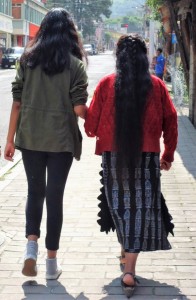
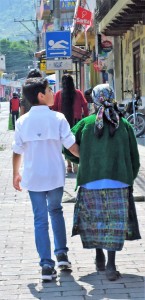



 ShareThis
ShareThis